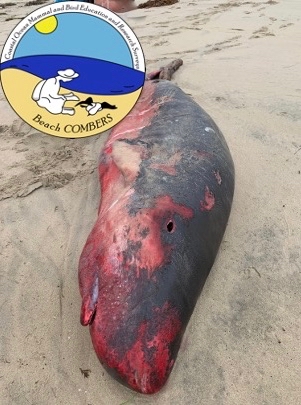On very rare occasions, dwarf sperm whales (Kogia sima) are found washed ashore on the beaches of Monterey Bay National Marine Sanctuary. A dead individual was found September 2020 and it is being studied by scientists from the California Academy of Sciences and Moss Landing Marine Laboratories. There have been roughly three other sightings in the last 40 years (one alive). Since 1997 volunteers with the BeachCOMBERS program conduct monthly surveys of beaches in the sanctuary, recording beach-cast organisms. These data inform resource managers about seasonal changes, long term trends and natural die-offs, and human-caused mass mortality events, such as those associated with oil spills.

The dwarf sperm whale is a toothed whale named after the waxy substance, spermaceti, found in its head. This organ is a sac of oil that helps the whales produce sound. Similar to squids, dwarf sperm whales can produce a dark, ink-like liquid that helps them escape from predators.
Dwarf sperm whales are found in temperate and tropical seas worldwide. The dwarf sperm whale appears very similar to the pygmy sperm whale. In the field, it is very difficult to distinguish between the two species because they can be so easily confused. Both species are poorly known due to the limited availability of information and their cryptic appearance at sea.
Dwarf sperm whales, like all marine mammals, are protected under the Marine Mammal Protection Act. NOAA Fisheries and its partners are working to conserve dwarf sperm whales and further our understanding of this species through research and conservation activities.
Dwarf sperm whales usually avoid vessels and planes, the tools that our scientists use to measure population size. Additionally, the whales only come to the water’s surface when the sea and weather conditions are very calm. As a result, scientists rarely see dwarf sperm whales at sea. This makes it difficult to estimate their minimum population size or current population trends.
Dwarf sperm whales have a small, compact body with a small dorsal fin located near the middle of their back. Each individual whale’s dorsal fin is a slightly different shape. While on the water’s surface, dwarf sperm whales have a low profile because their head and back are somewhat flat. Their head is sometimes described as shark-like because of its pointed snout and narrow, underslung lower jaw. They have a marking behind the eye that is often called a “false gill” because it looks similar to a fish’s gill cover or slit.
Dwarf sperm whales have a brown to blue-gray colored back. Their underside is paler with white or pink tones. They have up to three pairs of teeth in the upper jaw and seven to 13 pairs of teeth in the lower jaw. Their eyes are dark and bulging with a dark ring surrounding them.
Dwarf sperm whales can sometimes be confused with pygmy sperm whales, their closest relative. These two types of whales were not distinguished as separate species until 1966. In the wild, it is very difficult to distinguish between the two species because they have similar appearances and geographic ranges.